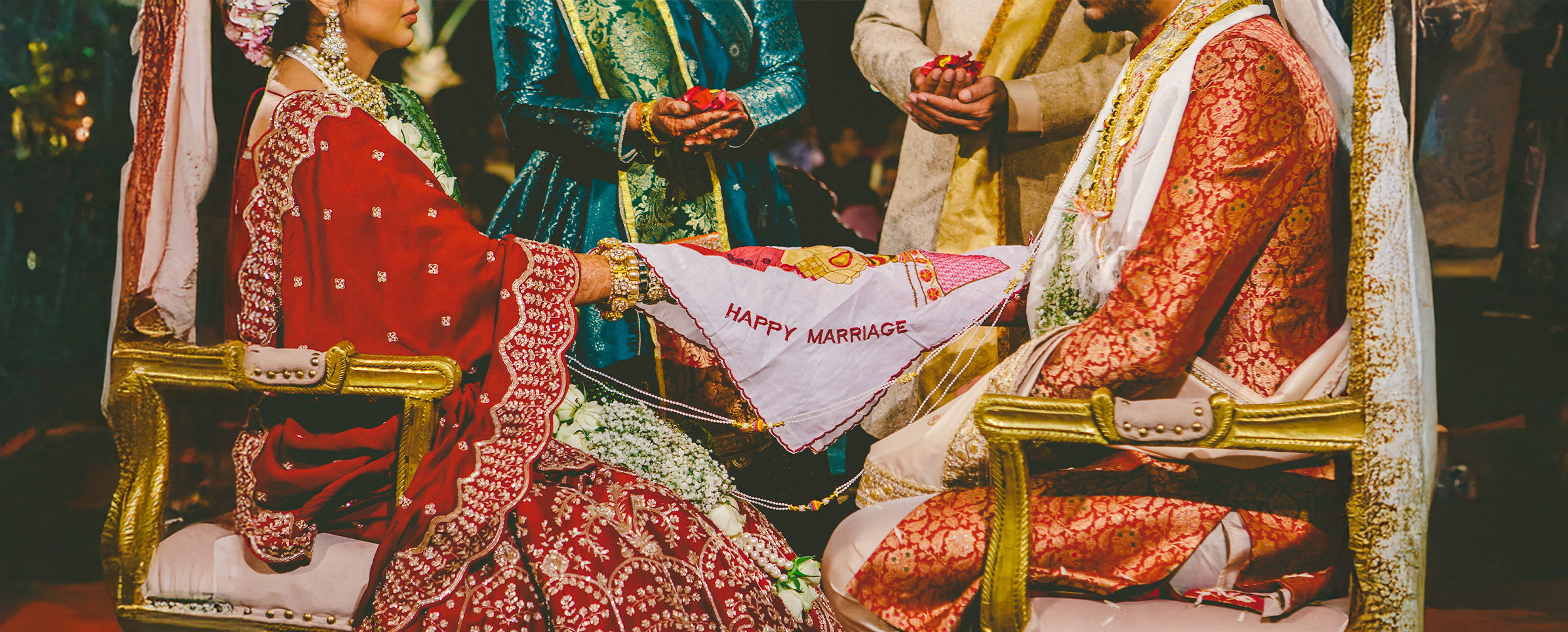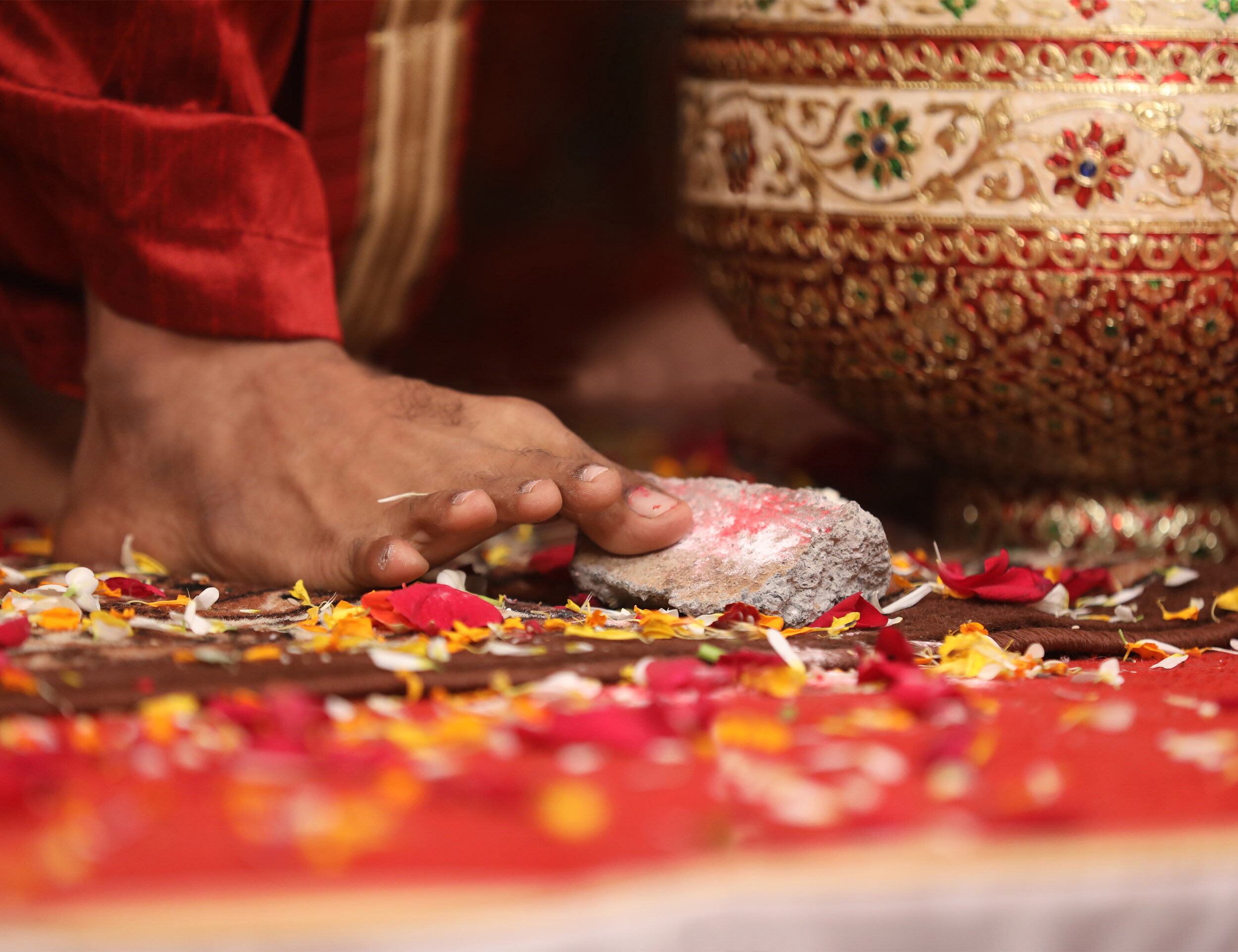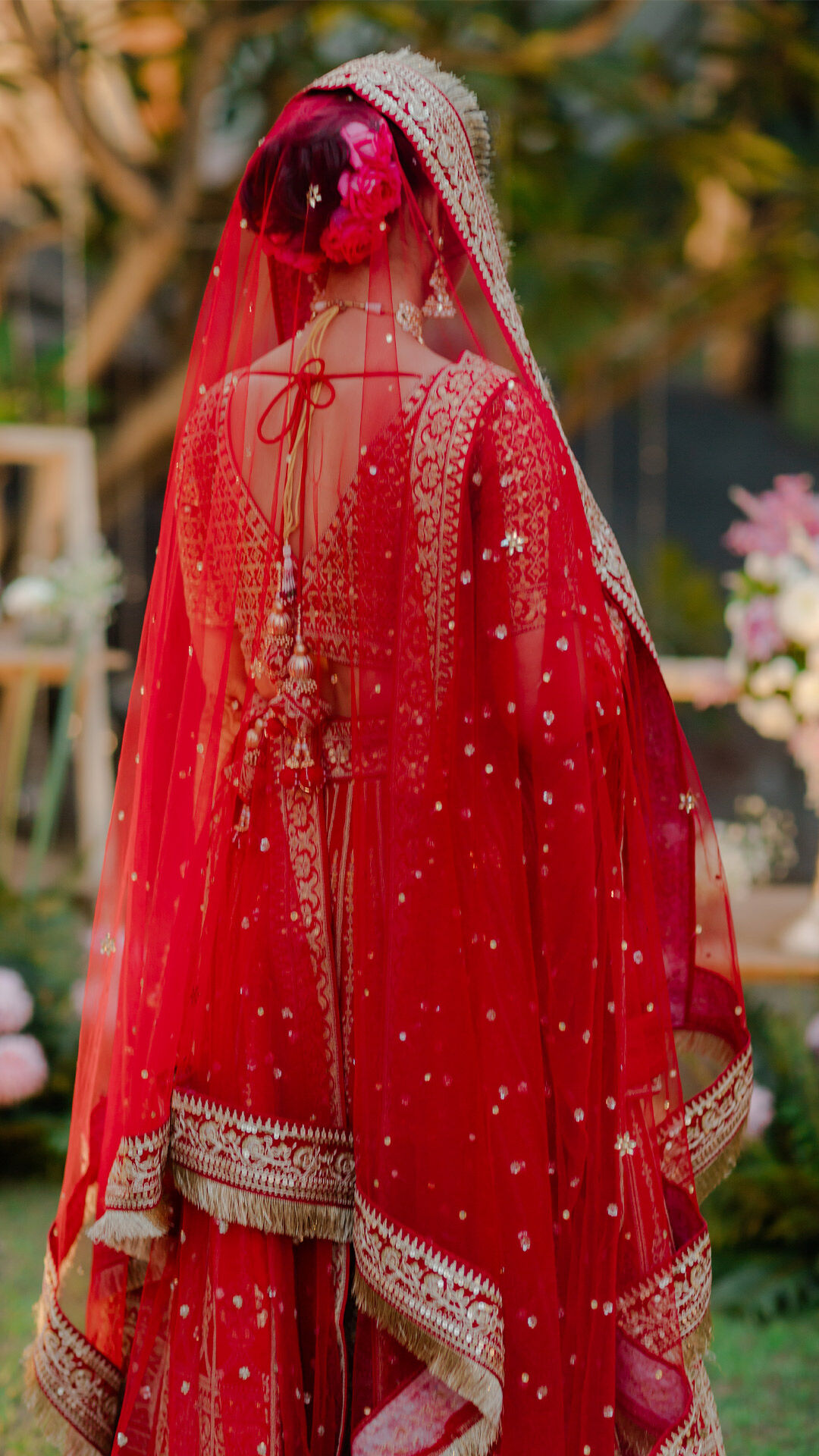STORIES BY MANYAVAR & MOHEY

Lifestyle
A Joyful Journey: Your Insider's Guide to a Gujarati Wedding Ceremony
Date 23 June 2025 Reading time: 7-10 mins
Imagine a sea of colourful sarees, the air filled with laughter and music, and a sense of celebration that's almost tangible. Welcome to a Gujarati wedding ceremony – a joyous affair that's steeped in custom, yet brimming with infectious energy.
In the vibrant tapestry of Indian weddings, Gujarati weddings stand out with their unique blend of rituals, festivity, and community spirit. From the playful pre-wedding ceremonies to the sacred rites on the big day, a Gujarati wedding is an experience that engages all your senses and touches your heart.
The Cultural Essence of Gujarati Weddings
At the heart of a Gujarati wedding ceremony lies a deep respect for custom and a love for celebration. Every ritual in a Gujarati wedding is imbued with meaning and symbolism. From the application of henna on the bride's hands to the tying of the mangalsutra, each ceremony is a beautiful thread in the rich tapestry of Gujarati culture.
Each Gujarati wedding ceremony is not only a celebration of love between two individuals but also a vibrant union of families and cultures. It’s where timeless customs meet high-energy dance, where spiritual blessings flow alongside bursts of colour, music, and food and being a part of a Gujarati wedding ceremony is something you'll remember for a lifetime.
Vibrance, Rituals, and Community Spirit
One of the most striking aspects of a Gujarati wedding ceremony is the sheer vibrancy of it all. The bride looks stunning in a bridal saree or a lehenga, often in hues of red, maroon, or green. The groom looks regal in a sherwani or a dapper kurta jacket set.
But beyond the visual splendour, what truly sets a Gujarati wedding apart is the warmth and inclusivity of the ceremonies. Everyone is involved in the celebrations, from close family to distant relatives and friends. It's a true testament to the strong sense of community that is so integral to Gujarati culture, and this spirit shines through in every Gujarati wedding ceremony, making it not just an event but an unforgettable shared experience.
Pre-Wedding Ceremonies
The festivities of a Gujarati wedding begin well before the actual wedding day. Here are some of the key pre-wedding rituals:
Chandlo Matli
The Chandlo Matli marks the formal acceptance of the alliance in a Gujarati wedding ceremony. The groom's family visits the bride's home bearing gifts in a decorative steel pot (matli). The bride's father applies a red mark (chandlo) on the groom's forehead, officially welcoming him into the family. This heartfelt ritual sets the tone for the warmth that defines every Gujarati wedding ceremony.
Gol Dhana
Also known as the engagement ceremony, Gol Dhana is an important part of a Gujarati wedding ceremony, involving the exchange of rings between the couple. Gol (jaggery) and dhana (coriander seeds) are distributed as symbols of sweetness and prosperity. This joyful ritual marks the couple’s first step towards marriage and, like many traditions in a Gujarati wedding ceremony, blends cultural symbolism with heartfelt celebration.
Mehendi Ceremony
The Mehendi ceremony is a fun-filled affair where the bride's hands and feet are adorned with intricate henna designs. Female relatives and friends also apply mehendi, amidst singing, dancing, and much laughter. In modern Gujarati weddings, the Mehendi function is often combined with the Sangeet. This vibrant event is an essential part of the Gujarati wedding program, setting the tone for the celebrations ahead. It’s a chance for everyone to come together and enjoy, making it a memorable part of the entire Gujarati wedding program.
Style Tip: Flaunt a beautiful green Banarasi saree featuring diamond woven patterns for a look that's perfect not only for the mehendi ceremony but for any part of the Gujarati wedding program.
Sangeet or Sanji
The sangeet evening is all about music, dance, and celebration. Both families put up performances, often rehearsed dances and skits, to honour the couple. This lively event is a highlight of the Gujarati wedding program, where everyone comes together to celebrate the joy of the occasion. It's a joyful prelude to the more formal rituals and an unforgettable part of the Gujarati wedding program.
Mameru (Mosalu)
In this ceremony, the bride's maternal uncle brings gifts for her, usually in the form of sarees, jewellery, and sweets. It symbolises the blessings and love of the maternal family, making it a special moment in the Gujarati wedding program. This ritual is an important part of the Gujarati wedding program, highlighting the close-knit bonds between the bride and her maternal side of the family.
Mandap Mahurat and Griha Shanti
On the day before the wedding, pujas are performed at both the bride's and the groom's homes to invoke the blessings of the Gods. The Mandap Mahurat involves setting up the wedding canopy and sanctifying it, while the Griha Shanti is performed for peace and prosperity in the household.
Wedding Day Ceremonies
The wedding day of a Gujarati marriage is a beautiful blend of solemnity and celebration. Here's a look at the key rituals:
Baraat and Swagatam
The groom arrives at the wedding venue with his Baraat, a joyous procession accompanied by music and dancing. The bride's family welcomes him with a tilak ceremony and often, a playful ritual where the bride's sisters steal his shoes!
Jaimala (Garland Exchange)
The bride and groom exchange garlands as a symbol of their acceptance of each other. This simple yet meaningful ritual marks the beginning of their journey together.
Madhuparka Ritual
In this ceremony, the groom is treated as an honoured guest. His feet are washed, and he is offered madhuparka (a mixture of honey, yoghurt, and ghee). This ritual signifies the warm welcome extended by the bride's family.
Kanyadaan and Hasta Milap
One of the most emotional moments, Kanyadaan, is when the bride's father gives her hand in marriage to the groom. This is followed by Hasta Milap, the joining of the couple's hands, symbolising the coming together of two souls.
In the Gujarati wedding ceremony, the groom is often seen flaunting a regal sherwani or a sophisticated kurta for men.
Mangal Pheras and Saptapadi
The couple takes seven rounds around the sacred fire, each round representing a vow of love, loyalty, and respect. These pheras are the essence of the Gujarati marriage rituals, sealing the bond between the couple. The pheras hold deep significance in Gujarati marriage rituals, as they symbolise the promises and commitments the couple makes to each other for a lifetime.
Sindoor and Mangalsutra Ritual
In a beautiful gesture, the groom applies sindoor (vermilion) on the bride's forehead and ties the mangalsutra around her neck. These are the visible symbols of their marital status and their commitment to each other. This intimate act is one of the most significant Gujarati marriage rituals, symbolising the union of two souls. The application of sindoor and the mangalsutra are central to Gujarati marriage rituals, marking the couple’s official bond in the eyes of their family and society.
Kansar and Aashirvaad
After the pheras, the newlyweds feed each other sweets, symbolising the promise to stand by each other through the sweetness and bitterness of life. They then seek the blessings of the elders, who shower them with love and wisdom. This is one of the most heartwarming Gujarati marriage rituals, reflecting the bond they share. Seeking the elders’ blessings is an important part of Gujarati marriage rituals, ensuring the couple’s journey is blessed with guidance and support.
Post-Wedding Rituals
Vidaai (Farewell)
With mixed emotions, the bride bids farewell to her family. The Vidaai is a poignant moment, symbolising her departure from her maternal home to start a new chapter with her husband. As one of the most emotional Gujarati marriage rituals, it signifies the bride's transition to a new life.
This farewell is a deeply significant part of Gujarati marriage rituals, marking the end of one chapter and the beginning of another.
Ghar Nu Laxmi (Bride's Welcome)
As she enters her new home, the bride is welcomed as the Ghar Nu Laxmi, the bringer of wealth and prosperity. She is greeted with rituals and embraced warmly by her new family, making it a heartfelt moment in the Gujarati wedding program. This special welcome is a beautiful part of the Gujarati wedding program, marking the bride's new beginning and her integration into her husband's family.
The Soulful Journey of a Gujarati Wedding
A Gujarati wedding ceremony is more than just a series of rituals – it's a soulful journey that binds two hearts, two families, and sometimes even two communities. From the lively Garba nights to the emotional Kanyadaan, every moment is suffused with love, laughter, and a deep sense of belonging.
Whether you're planning your own Gujarati wedding or attending one, immerse yourself in the beauty and significance of each ritual. And as you embark on this joyous journey, consider adding a touch of elegance with Manyavar's exquisite collection of wedding wear for men and Mohey's stunning bridal outfits. From regal sherwanis to graceful lehengas, we have ensembles that perfectly capture the essence of a Gujarati wedding.







